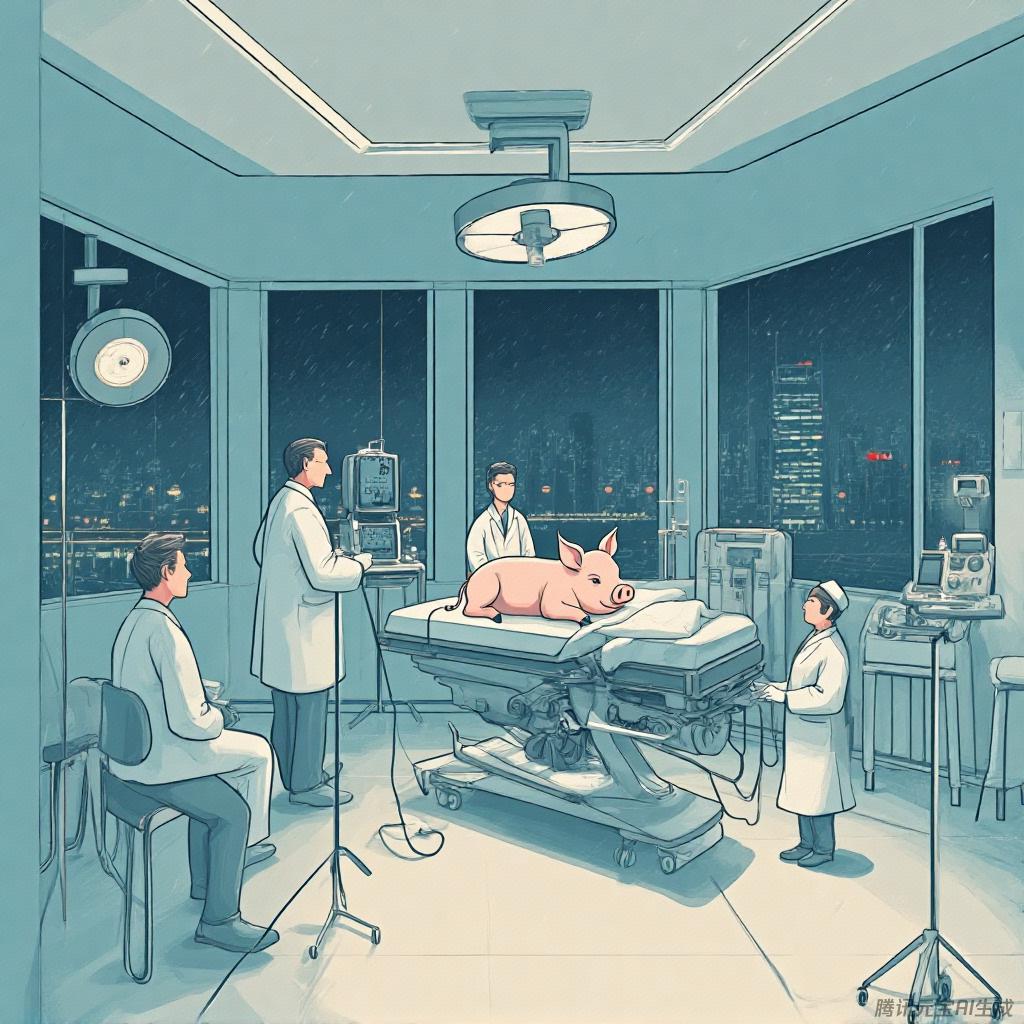猪器官移植的理论可行性:基因编辑与免疫调控的双重突破 / Theoretical Feasibility of Pig Organ Xenotransplantation: Breakthroughs in Gene Editing and Immune Regulation
器官短缺是全球性医疗危机,仅中国每年约30万患者需器官移植,但仅约2万人可获得手术机会。异种移植(尤其是猪器官)被视为最具潜力的解决方案,其可行性基于以下理论证据:
一、猪的生物学适配性
1. 解剖与生理兼容性猪的心、肾、肝等器官在大小、代谢功能及血管结构与人类相似度达80%-90%,心血管系统匹配度尤高。猪作为杂食动物,其消化代谢与人类接近,药物测试响应一致,为跨物种功能兼容提供基础。
2. 伦理与规模化优势相较于灵长类动物,猪繁殖快(6个月达成年体型)、饲养成本低、产仔数多,且伦理争议较小。猪与人亲缘关系较远,降低人畜共患病风险。
二、基因编辑技术攻克核心障碍
1. 消除内源性病毒风险猪基因组携带的内源性逆转录病毒(PERVs)曾被视为重大安全隐患。2017年,中国团队利用CRISPR/Cas9技术一次性敲除猪肾细胞中62个PERVs拷贝,使病毒感染力下降1000倍,并培育出PERVs失活的克隆猪,从根源阻断跨物种感染。
2. 克服免疫排斥反应
- 超急性排斥:由猪血管内皮细胞表面的α-1,3-半乳糖(α-Gal)抗原引发。敲除其合成酶基因(GGTA1)并转入人补体调节蛋白(如hCD46、hDAF),可有效抑制补体激活,延长移植物存活时间。
- 急性血管排斥:通过表达人CD47蛋白,激活巨噬细胞表面的SIRPα抑制信号,减少炎症因子释放和血栓形成。
- 凝血功能障碍:转入人血栓调节蛋白(THBD)和组织因子途径抑制物(TFPI)基因,纠正猪-人凝血系统不兼容性。
3. 多基因协同编辑当前前沿供体猪需同时敲除3-8个抗原基因(如GGTA1、CMAH、β4GalNT2),并转入9-13个人源基因(如补体调节蛋白、凝血因子)。例如中国2025年报道的“8基因编辑猪”,其肝肾联合移植至脑死亡患者体内后功能正常。
三、实验与临床前验证
1. 非人灵长类实验猪肾在狒狒体内存活达136天,猪心脏移植存活纪录达945天,证明长期功能可行性。
2. 脑死亡受体研究
- 美国2021年首次将基因编辑猪肾移植至脑死亡者体内,54小时内尿液生成及肌酐水平均正常,未见超急性排斥。
- 2025年中国团队完成全球首例猪肝肾联合移植,采用“异位肾移植+原位辅助肝移植”策略,器官功能良好。
3. 活体临床试验启动2025年美国FDA批准猪肾脏移植临床试验,首例活体患者术后3个月存活,标志从实验探索进入临床验证阶段。
四、未来挑战与优化方向
尽管基因编辑已解决核心排斥问题,但慢性排斥机制、免疫细胞浸润规律(如巨噬细胞主导的早期排斥)及长期生物安全性仍需深研。新兴策略如仿生糖萼层(构建血管“隐形铠甲”)和胸腺联合移植(诱导T细胞耐受)有望进一步提升存活率。
结论
猪器官移植的理论可行性已通过基因编辑技术和跨物种生理兼容性得到充分验证,并在实验模型中取得突破性进展。随着多基因修饰猪的优化及靶向免疫抑制方案的完善,猪器官有望在未来十年内成为常规移植供源,彻底改写器官短缺困局。
文献来源:综合国际权威医学期刊及中美最新临床研究(2021-2025年)。
——————————
The global organ shortage constitutes a medical crisis, with approximately 300,000 patients in China alone requiring transplants annually, yet only about 20,000 receive surgeries. Xenotransplantation—particularly using pig organs—has emerged as the most promising solution. Its feasibility is substantiated by the following theoretical evidence:
I. Biological Compatibility of Pigs
1. Anatomical and Physiological HomologyPorcine hearts, kidneys, livers, and other organs exhibit 80%-90% similarity to humans in size, metabolic function, and vascular structure, with cardiovascular systems demonstrating particularly high compatibility. As omnivores, pigs share digestive and metabolic traits with humans, showing consistent responses in drug testing—providing a foundation for cross-species functional adaptation.
2. Ethical and Scalability AdvantagesCompared to primates, pigs breed rapidly (reaching adult size in 6 months), have lower rearing costs, produce larger litters, and raise fewer ethical concerns. Their greater genetic distance from humans reduces zoonotic disease risks.
II. Gene Editing Overcoming Core Barriers
1. Eliminating Endogenous Viral ThreatsPorcine endogenous retroviruses (PERVs) were historically deemed major safety hazards. In 2017, a Chinese team used CRISPR/Cas9 to delete all 62 PERV loci in pig kidney cells, reducing viral infectivity by 1,000-fold. This resulted in cloned pigs with inactivated PERVs, eliminating cross-species transmission risks.
2. Addressing Immune Rejection
- Hyperacute Rejection: Caused by α-1,3-galactose (α-Gal) antigens on pig vascular endothelial cells. Knocking out the GGTA1 gene (encoding α-Gal) and introducing human complement regulators (e.g., hCD46, hDAF) inhibits complement activation and prolongs graft survival.
- Acute Vascular Rejection: Expression of human CD47 activates the SIRPα inhibitory pathway on macrophages, reducing inflammatory cytokine release and thrombogenesis.
- Coagulation Dysregulation: Insertion of human thrombomodulin (THBD) and tissue factor pathway inhibitor (TFPI) genes corrects interspecies coagulation incompatibility.
3. Multi-Gene CoordinationAdvanced donor pigs now require knockout of 3–8 antigen genes (e.g., GGTA1, CMAH, β4GalNT2) and insertion of 9–13 human transgenes (e.g., complement regulators, coagulation factors). China’s 2025 "8-gene edited pig" demonstrated normal renal and hepatic function in brain-dead human recipients after combined transplantation.
III. Preclinical and Clinical Validation
1. Non-Human Primate StudiesPig kidneys survived up to 136 days in baboons, while pig hearts achieved 945-day survival records, confirming long-term functionality.
2. Brain-Dead Human Recipient Research
- The 2021 U.S. trial transplanted gene-edited pig kidneys into brain-dead subjects, with normal urine output and creatinine levels for 54 hours without hyperacute rejection.
- China’s 2025 pioneering combined liver-kidney pig transplant used an "ectopic renal graft + orthotopic auxiliary liver graft" strategy, maintaining optimal organ function.
3. Living Human TrialsIn 2025, the FDA approved Phase I pig kidney trials, with the first living patient surviving >3 months postoperatively—marking the transition from experimental to clinical validation.
IV. Future Challenges and Optimization
Despite progress in overcoming acute rejection, chronic rejection mechanisms, immune cell infiltration dynamics (e.g., macrophage-dominated early rejection), and long-term biosafety require deeper study. Emerging strategies include biomimetic glycocalyx coatings (creating vascular "invisibility cloaks") and thymus cotransplantation (inducing T-cell tolerance) to further enhance survival rates.
Conclusion
The theoretical feasibility of porcine xenotransplantation has been robustly validated through gene-editing technologies and cross-species physiological compatibility, with breakthrough progress in experimental models. With refined multi-gene modifications and targeted immunosuppressive protocols, pig organs are poised to become routine clinical transplant sources within the next decade, fundamentally resolving the organ shortage crisis.
Source: Integrated data from leading international medical journals and recent Sino-U.S. clinical studies (2021–2025).
一、猪的生物学适配性
1. 解剖与生理兼容性猪的心、肾、肝等器官在大小、代谢功能及血管结构与人类相似度达80%-90%,心血管系统匹配度尤高。猪作为杂食动物,其消化代谢与人类接近,药物测试响应一致,为跨物种功能兼容提供基础。
2. 伦理与规模化优势相较于灵长类动物,猪繁殖快(6个月达成年体型)、饲养成本低、产仔数多,且伦理争议较小。猪与人亲缘关系较远,降低人畜共患病风险。
二、基因编辑技术攻克核心障碍
1. 消除内源性病毒风险猪基因组携带的内源性逆转录病毒(PERVs)曾被视为重大安全隐患。2017年,中国团队利用CRISPR/Cas9技术一次性敲除猪肾细胞中62个PERVs拷贝,使病毒感染力下降1000倍,并培育出PERVs失活的克隆猪,从根源阻断跨物种感染。
2. 克服免疫排斥反应
- 超急性排斥:由猪血管内皮细胞表面的α-1,3-半乳糖(α-Gal)抗原引发。敲除其合成酶基因(GGTA1)并转入人补体调节蛋白(如hCD46、hDAF),可有效抑制补体激活,延长移植物存活时间。
- 急性血管排斥:通过表达人CD47蛋白,激活巨噬细胞表面的SIRPα抑制信号,减少炎症因子释放和血栓形成。
- 凝血功能障碍:转入人血栓调节蛋白(THBD)和组织因子途径抑制物(TFPI)基因,纠正猪-人凝血系统不兼容性。
3. 多基因协同编辑当前前沿供体猪需同时敲除3-8个抗原基因(如GGTA1、CMAH、β4GalNT2),并转入9-13个人源基因(如补体调节蛋白、凝血因子)。例如中国2025年报道的“8基因编辑猪”,其肝肾联合移植至脑死亡患者体内后功能正常。
三、实验与临床前验证
1. 非人灵长类实验猪肾在狒狒体内存活达136天,猪心脏移植存活纪录达945天,证明长期功能可行性。
2. 脑死亡受体研究
- 美国2021年首次将基因编辑猪肾移植至脑死亡者体内,54小时内尿液生成及肌酐水平均正常,未见超急性排斥。
- 2025年中国团队完成全球首例猪肝肾联合移植,采用“异位肾移植+原位辅助肝移植”策略,器官功能良好。
3. 活体临床试验启动2025年美国FDA批准猪肾脏移植临床试验,首例活体患者术后3个月存活,标志从实验探索进入临床验证阶段。
四、未来挑战与优化方向
尽管基因编辑已解决核心排斥问题,但慢性排斥机制、免疫细胞浸润规律(如巨噬细胞主导的早期排斥)及长期生物安全性仍需深研。新兴策略如仿生糖萼层(构建血管“隐形铠甲”)和胸腺联合移植(诱导T细胞耐受)有望进一步提升存活率。
结论
猪器官移植的理论可行性已通过基因编辑技术和跨物种生理兼容性得到充分验证,并在实验模型中取得突破性进展。随着多基因修饰猪的优化及靶向免疫抑制方案的完善,猪器官有望在未来十年内成为常规移植供源,彻底改写器官短缺困局。
文献来源:综合国际权威医学期刊及中美最新临床研究(2021-2025年)。
——————————
The global organ shortage constitutes a medical crisis, with approximately 300,000 patients in China alone requiring transplants annually, yet only about 20,000 receive surgeries. Xenotransplantation—particularly using pig organs—has emerged as the most promising solution. Its feasibility is substantiated by the following theoretical evidence:
I. Biological Compatibility of Pigs
1. Anatomical and Physiological HomologyPorcine hearts, kidneys, livers, and other organs exhibit 80%-90% similarity to humans in size, metabolic function, and vascular structure, with cardiovascular systems demonstrating particularly high compatibility. As omnivores, pigs share digestive and metabolic traits with humans, showing consistent responses in drug testing—providing a foundation for cross-species functional adaptation.
2. Ethical and Scalability AdvantagesCompared to primates, pigs breed rapidly (reaching adult size in 6 months), have lower rearing costs, produce larger litters, and raise fewer ethical concerns. Their greater genetic distance from humans reduces zoonotic disease risks.
II. Gene Editing Overcoming Core Barriers
1. Eliminating Endogenous Viral ThreatsPorcine endogenous retroviruses (PERVs) were historically deemed major safety hazards. In 2017, a Chinese team used CRISPR/Cas9 to delete all 62 PERV loci in pig kidney cells, reducing viral infectivity by 1,000-fold. This resulted in cloned pigs with inactivated PERVs, eliminating cross-species transmission risks.
2. Addressing Immune Rejection
- Hyperacute Rejection: Caused by α-1,3-galactose (α-Gal) antigens on pig vascular endothelial cells. Knocking out the GGTA1 gene (encoding α-Gal) and introducing human complement regulators (e.g., hCD46, hDAF) inhibits complement activation and prolongs graft survival.
- Acute Vascular Rejection: Expression of human CD47 activates the SIRPα inhibitory pathway on macrophages, reducing inflammatory cytokine release and thrombogenesis.
- Coagulation Dysregulation: Insertion of human thrombomodulin (THBD) and tissue factor pathway inhibitor (TFPI) genes corrects interspecies coagulation incompatibility.
3. Multi-Gene CoordinationAdvanced donor pigs now require knockout of 3–8 antigen genes (e.g., GGTA1, CMAH, β4GalNT2) and insertion of 9–13 human transgenes (e.g., complement regulators, coagulation factors). China’s 2025 "8-gene edited pig" demonstrated normal renal and hepatic function in brain-dead human recipients after combined transplantation.
III. Preclinical and Clinical Validation
1. Non-Human Primate StudiesPig kidneys survived up to 136 days in baboons, while pig hearts achieved 945-day survival records, confirming long-term functionality.
2. Brain-Dead Human Recipient Research
- The 2021 U.S. trial transplanted gene-edited pig kidneys into brain-dead subjects, with normal urine output and creatinine levels for 54 hours without hyperacute rejection.
- China’s 2025 pioneering combined liver-kidney pig transplant used an "ectopic renal graft + orthotopic auxiliary liver graft" strategy, maintaining optimal organ function.
3. Living Human TrialsIn 2025, the FDA approved Phase I pig kidney trials, with the first living patient surviving >3 months postoperatively—marking the transition from experimental to clinical validation.
IV. Future Challenges and Optimization
Despite progress in overcoming acute rejection, chronic rejection mechanisms, immune cell infiltration dynamics (e.g., macrophage-dominated early rejection), and long-term biosafety require deeper study. Emerging strategies include biomimetic glycocalyx coatings (creating vascular "invisibility cloaks") and thymus cotransplantation (inducing T-cell tolerance) to further enhance survival rates.
Conclusion
The theoretical feasibility of porcine xenotransplantation has been robustly validated through gene-editing technologies and cross-species physiological compatibility, with breakthrough progress in experimental models. With refined multi-gene modifications and targeted immunosuppressive protocols, pig organs are poised to become routine clinical transplant sources within the next decade, fundamentally resolving the organ shortage crisis.
Source: Integrated data from leading international medical journals and recent Sino-U.S. clinical studies (2021–2025).
附件文件 File

